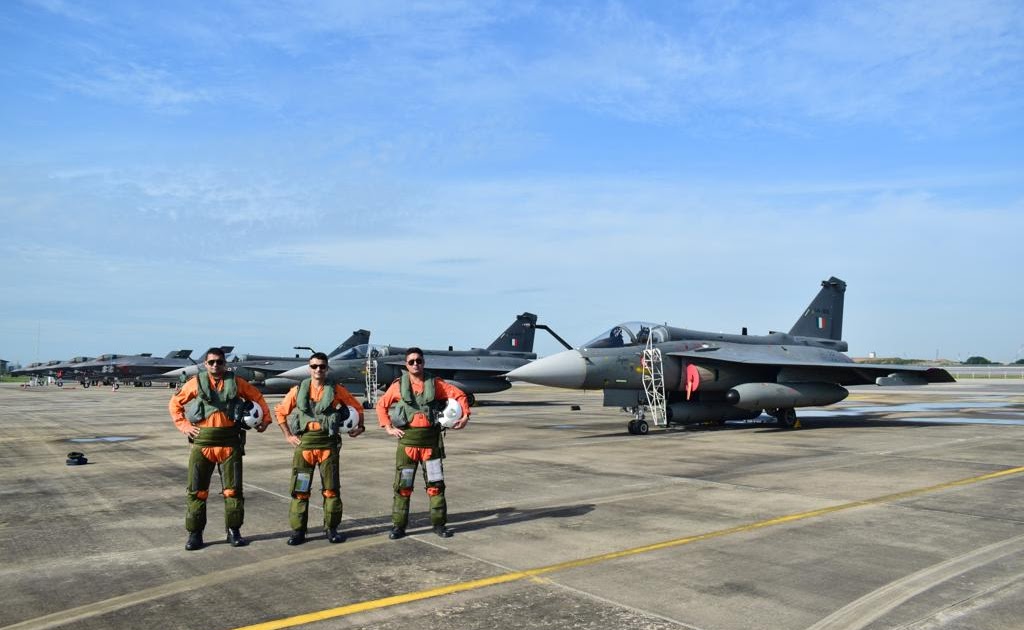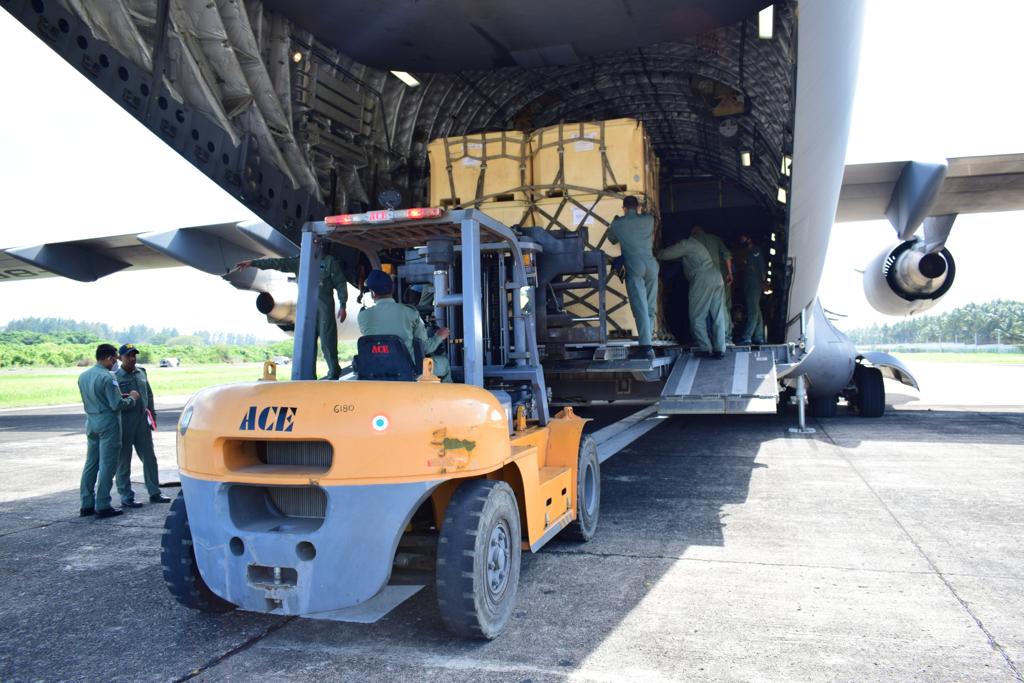
The Tejas Flight Line at Air Force Base, Sulur, from where the fighters flew to the Singapore Airshow 2022
By Vikas Gupta
Defence News of India, 16 Feb 22
From Tuesday to Friday, a detachment of Indian Air Force (IAF) Tejas Mark 1 fighters, supported by a team of 44, will perform aerobatic displays over Changi International Airport in Singapore, the one of the most watched attractions of the Singapore Airshow – 2022.
The IAF team rushed there at the invitation of Singapore, being one of the potential suppliers of “Capability 55”: which is the code name of the Royal Malaysian Air Force (RMAF) plan to purchase 18 light fighters in the coming year and another 18 from 2025.
Malaysia will choose from a bouquet of light fighters on offer. In addition to the Tejas Mark 1A, he was offered the South Korean FA-50 Golden Eagle, the Russian MiG-35 and the Sino-Pakistani JF-17 Thunder, which already equips the Pakistan Air Force (PAF). Two smaller training aircraft are also in competition: Leonardo’s M-346FA and the Russian Yakovlev-130.
While industry observers place great importance on the Tejas Mark 1A, the haste with which the Indian team was sent to Singapore is concerning; and the feeling that New Delhi is participating without clear goals and objectives.
During the first international outings of the Tejas – including the Bahrain International Air Show in 2016, the Langkawi International Maritime Aerospace Expo (LIMA) in 2019 and the Dubai Air Show-2021 last November – the focus was on demonstrating flight performance.

Loading to leave for Singapore Airshow 2022
But while the IAF and Hindustan Aeronautics Ltd (HAL) had put on engaging flight displays, there was no clear understanding of what they were supposed to achieve.
“We have not sufficiently considered the crucial issues. Our short-term customers were obvious, but who were our medium- and long-term customers? What was our objective in participating in these air shows? In what aspects did we need to impress potential buyers? said a former test pilot with extensive experience flying the Tejas.
Given New Delhi’s “Atmanirbhar Bharat” (self-governing India) policy, one of the main objectives of participating in international air shows was for India to establish itself as a seller rather than a buyer of military aircraft . This would draw attention to Tejas at a time when buying countries were sending out Requests for Information (RFIs) and Requests for Proposals (RFPs). It was felt that the reputation of the Tejas would be enhanced by performing flawless aerobatics in the presence of our chosen audience.
“In fact, the way to sell fighters is not to have them rehearse aerobatics, day after day. It might be better for the seller to play and replay simulated combat missions, which respond directly to the national security needs of the buyer,” says an IAF pilot.
A defense industry executive compares the opportunity presented by an air show to negotiating with a wealthy buyer walking into an exclusive store, having made an appointment beforehand. In both cases, it must be decided in advance who will be the designated seller, who will support him, and what arguments and materials he will use to convince the buyer.
Seriousness is further conveyed by the prior preparation of a composite team responsible for briefing and guiding the buyer. The team should include representatives from the platform developer (in this case, the DRDO), the production agency (HAL), and the user (the IAF).
Major fender sellers usually have a dedicated department to address buyer concerns. The Pentagon has an Office of Defense Cooperation (ODC) to oversee arms sales. In Russia, defense exports are handled by Rosoboronexport.
India has no such specialized agency; only responsibilities distributed between the departments. To stimulate defense exports, an “Ordnance List” was promulgated; a standard operating procedure (SOP) has been promulgated for the export of these items; a an end-to-end online portal was developed to receive and process authorisations; as well as several other export promotion measures. However, with the exception of a small cell in the Department of Defense Promotion, no single agency is specifically responsible for all export-related functions.
Such a department would provide institutional expertise in handling issues such as end-user certification and the complex authorizations needed to sell an aircraft (like the Tejas) that has systems and subsystems from different countries. Permissions would be required to transfer an airborne radar from Israel, an ejection seat from the UK and a glass cockpit from France.
Discussing and resolving such issues is the real business of an airshow, where government-to-government and government-to-business meetings are held well in advance. Thereafter, the air show provides a venue for smooth interaction between seller and buyer.
Fielding aircraft in an air show may or may not result in orders, but any debacle in an air show, such as a crash, is usually disastrous. An example is the Tupolev-144, which the Soviet Union touted as the world’s first supersonic airliner – it first went supersonic on the 5and June 1969, four months before the Concorde, and flew at Mach 2 on May 26, 1970. But a fatal crash of the Tu-144 at the Paris Air Show in June 1973 dealt a fatal blow to the program.
Similarly, on October 10, 1984, an F-20 Tigershark fighter, which Northrop was developing for the export market, crashed in South Korea during a demonstration flight. An investigation cleared the F-20 of mechanical or design flaws, but another Tigershark crashed in May 1985 in Labrador, killing the pilot who was practicing his aerobatic routine for the Paris Air Show.
On the other hand, disaster could turn into triumph, as the Russians did in Paris in 1989, after a MiG-29 Fulcrum, piloted by legendary Russian test pilot Anatoly Kvochur, crashed after a bird strike. As the stricken aircraft dived towards the ground, Kvochur pulled it away from the crowd and ejected 2.5 seconds before the fighter touched down. Miraculously, he landed unscathed, just 30 meters from the blazing fireball of the crashed plane. The Russians touted its Zvezda K-36D ejection seat as a pilot savior and bolstered the argument after a second crash four years later when two MiG-29 pilots successfully ejected after a mid-air collision .
For an emerging exporter like India, showcasing a new fighter at a major air show would require clear lines of authority and control. At an event like the Singapore Airshow, a local official, such as India’s Military Adviser (MA) at the Singapore Embassy, should have been in charge of the exercise.
To fly the Indian flag, an Indian Navy destroyer should have been deployed to Singapore well before its time. While displaying New Delhi’s presence prominently, it would also have provided a suitable venue for side discussions with the RMAF. Admittedly, the MoD will have rented a chalet for delicate discussions outside the limelight. However, a higher degree of government involvement is signaled by the organization of a meeting on a warship. And a destroyer’s helicopter deck provides an unparalleled venue for hosting a cocktail party, serenaded by a navy band.
The MoD and IAF did not respond to a request for comment.






